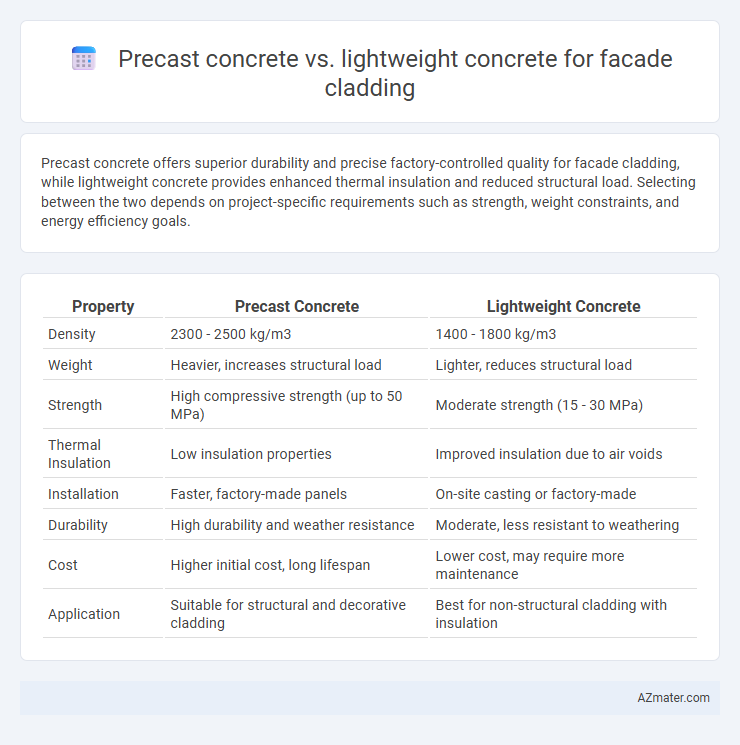Precast concrete offers superior durability and precise factory-controlled quality for facade cladding, while lightweight concrete provides enhanced thermal insulation and reduced structural load. Selecting between the two depends on project-specific requirements such as strength, weight constraints, and energy efficiency goals.
Table of Comparison
| Property | Precast Concrete | Lightweight Concrete |
|---|---|---|
| Density | 2300 - 2500 kg/m3 | 1400 - 1800 kg/m3 |
| Weight | Heavier, increases structural load | Lighter, reduces structural load |
| Strength | High compressive strength (up to 50 MPa) | Moderate strength (15 - 30 MPa) |
| Thermal Insulation | Low insulation properties | Improved insulation due to air voids |
| Installation | Faster, factory-made panels | On-site casting or factory-made |
| Durability | High durability and weather resistance | Moderate, less resistant to weathering |
| Cost | Higher initial cost, long lifespan | Lower cost, may require more maintenance |
| Application | Suitable for structural and decorative cladding | Best for non-structural cladding with insulation |
Introduction to Façade Cladding Materials
Precast concrete and lightweight concrete are prominent materials used in facade cladding, each offering distinct advantages in construction and aesthetics. Precast concrete provides high durability, dimensional accuracy, and design versatility, making it ideal for complex architectural patterns and large-scale panels. Lightweight concrete reduces structural load due to its lower density, enhances thermal insulation, and simplifies installation, which is beneficial for energy-efficient building envelopes.
What is Precast Concrete Cladding?
Precast concrete cladding consists of factory-made concrete panels cast into specific shapes and sizes, designed to be installed on building exteriors. It offers high durability, dimensional accuracy, and fast installation, making it ideal for facade applications requiring strength and aesthetic versatility. Compared to lightweight concrete, precast concrete cladding delivers superior structural integrity and resistance to environmental elements, enhancing building performance and longevity.
What is Lightweight Concrete Cladding?
Lightweight concrete cladding consists of exterior panels made from concrete that incorporates lightweight aggregates such as expanded clay, shale, or pumice, reducing the material's density and improving thermal insulation. This type of cladding enhances building energy efficiency by offering superior insulation properties compared to traditional precast concrete, while maintaining structural integrity and durability. Lightweight concrete panels allow for easier installation due to their reduced weight, making them a popular choice for facade applications where load reduction and better thermal performance are priorities.
Structural Performance Comparison
Precast concrete offers superior structural performance for facade cladding due to its high compressive strength, durability, and ability to withstand heavy loads and impact. Lightweight concrete provides advantages in reducing overall building weight, improving seismic resistance, and easing installation but typically exhibits lower compressive strength and stiffness. Structural performance comparison favors precast concrete for applications requiring enhanced load-bearing capacity and long-term durability, while lightweight concrete is preferred where weight reduction and thermal insulation are prioritized.
Aesthetic Flexibility and Design Options
Precast concrete offers extensive aesthetic flexibility due to its moldability, allowing for intricate textures, patterns, and custom shapes in facade cladding. Lightweight concrete provides design versatility with the advantage of reduced weight, enabling larger panels and easier installation while maintaining a variety of finishes. Both materials support diverse architectural expressions, but precast concrete excels in complex decorative details, whereas lightweight concrete emphasizes practical design adaptability.
Installation and Construction Speed
Precast concrete offers rapid installation for facade cladding due to factory-controlled conditions and modular panel fabrication, significantly reducing on-site labor and construction time. Lightweight concrete panels, while easier to handle and transport because of their reduced density, may require more intricate curing and reinforcement processes that can extend overall construction duration. Contractors often prefer precast concrete for projects with tight schedules, leveraging its precise manufacturing to accelerate facade assembly without compromising structural integrity.
Durability and Weather Resistance
Precast concrete offers superior durability and weather resistance for facade cladding due to its dense composition and factory-controlled curing process, which minimizes porosity and enhances strength against harsh environmental conditions. Lightweight concrete, while easier to handle and install, typically has higher porosity and lower compressive strength, making it less resistant to freeze-thaw cycles and moisture penetration. Therefore, precast concrete is generally preferred for long-lasting exteriors exposed to severe weather, ensuring extended facade integrity and reduced maintenance costs.
Energy Efficiency and Thermal Performance
Precast concrete facade cladding offers high thermal mass, enhancing energy efficiency by stabilizing indoor temperatures and reducing heating and cooling demands. Lightweight concrete provides superior insulation properties due to its lower density and higher porosity, leading to improved thermal resistance and reduced heat transfer. Selecting between precast and lightweight concrete depends on balancing thermal performance needs with structural requirements and local climate conditions.
Cost Analysis and Life Cycle Considerations
Precast concrete offers higher initial costs due to complex mold fabrication but benefits from faster installation and reduced labor expenses, making it cost-effective for large-scale facade cladding projects. Lightweight concrete reduces dead loads, lowering structural support costs and potential foundation expenses, though its raw material costs can be higher and installation may require specialized handling. Life cycle analysis favors precast concrete for its durability, low maintenance, and superior resistance to environmental factors, while lightweight concrete provides energy efficiency advantages through improved thermal insulation, potentially reducing long-term operational costs.
Environmental Impact and Sustainability
Precast concrete for facade cladding offers durability and efficient use of materials, often incorporating recycled aggregates to reduce environmental impact. Lightweight concrete reduces the overall structural load, lowering energy consumption during transportation and installation, and typically includes industrial byproducts like fly ash, enhancing sustainability. Both options contribute to energy-efficient building envelopes, but lightweight concrete provides superior thermal insulation, leading to reduced operational energy use and carbon footprint over the building lifecycle.

Infographic: Precast concrete vs Lightweight concrete for Façade cladding
 azmater.com
azmater.com